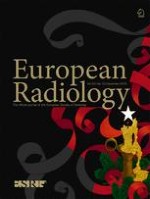Erschienen in:

01.12.2015 | Magnetic Resonance
Four-year cardiac magnetic resonance (CMR) follow-up of patients treated with percutaneous pulmonary valve stent implantation
verfasst von:
Francesco Secchi, Elda Chiara Resta, Paola Maria Cannaò, Silvia Tresoldi, Gianfranco Butera, Mario Carminati, Francesco Sardanelli
Erschienen in:
European Radiology
|
Ausgabe 12/2015
Einloggen, um Zugang zu erhalten
Abstract
Objectives
To investigate follow-up after percutaneous pulmonary valve implantation (PPVI).
Methods
Forty patients with pulmonary conduit dysfunction (males/females 24/16; 21 ± 08 years; 12 tetralogy of Fallot, 11 aortic valve disease, 17 other congenital heart disease) were planned for CMR before PPVI and repeated 7 times up to 48 months. CMR prospective results regarded: pressure gradient (PG) and regurgitation fraction (RF); end-diastolic volume, end-systolic volume, and stroke volume indexed to body surface area (EDVI, ESVI, and SVI); ejection fraction (EF) of right and left ventricles (RV, LV). A Friedman test was used for comparisons.
Results
Overall, PG (31 ± 06 to 16 ± 4 mmHg), RF (16 ± 17 to 0.3 ± 1 %), RVEDVI (82 ± 38 to 58 ± 12 ml/m2), and RVESVI (44 ± 12 to 30 ± 13 ml/m2) declined (p < 0.001), RVEF (49 ± 13 to 58 ± 12 %) and RVSVI (from 38 ± 14 to 40 ± 8 ml/m2) increased (p < 0.001), LVEDVI (67 ± 17 to 73 ± 18 ml/m2) and LVSVI (37 ± 11 to 43 ± 10 ml/m2) increased (p = 0.034 and p < 0.001). Two patients had valve fracture at 24 and 36 months and underwent surgery. One patient had stent restenosis at 24 months and underwent percutaneous retreatment. Baseline/follow-up CMR did not predict PPVI failure.
Conclusions
CMR demonstrated restored pulmonary conduit function, reduced RV volumes and increased RV and LV function but did not predict valve fracture/restenosis.
Key points
• A CMR 4-year follow-up after PPVI showed restored pulmonary conduit function
• RV volumes were significantly reduced
• RV function was significantly better in terms of increased EF and SVI
• LV function was significantly better in terms of increased EDVI and SVI
• Baseline/follow-up CMR did not predict three cases of PPVI failure